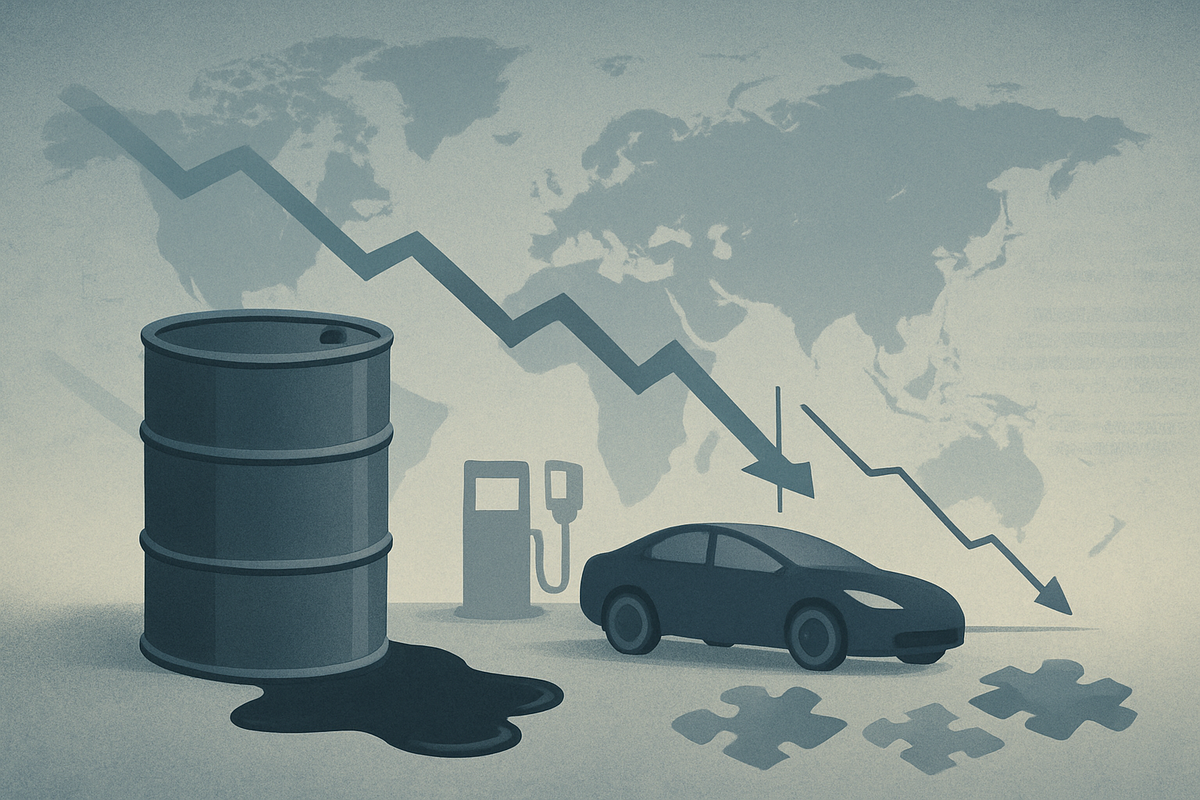
The global financial landscape is poised for a significant shift as the World Bank forecasts a broad-based decline in commodity prices, projecting them to reach a six-year low by 2026. This anticipated downturn, marking the fourth consecutive year of depreciation, is driven primarily by a burgeoning oil surplus, weakening global demand, and persistent policy uncertainty. While offering a much-needed reprieve from inflationary pressures for many nations, this outlook presents considerable challenges for commodity-exporting economies and reshapes investment strategies across various sectors.
The World Bank's latest Commodity Markets Outlook, released in late 2024 and extending its forecast through 2026, paints a picture of sustained price softening. Energy prices are expected to lead the decline, with a projected 12% fall in 2025 and an additional 10% in 2026. Brent crude oil prices, a key global benchmark, are specifically forecast to drop from an average of $68 per barrel in 2025 to a five-year low of $60 per barrel by 2026. Food prices are also anticipated to ease, with a 6.1% decline in 2025, primarily due to improved agricultural supply. This broad-based depreciation of approximately 7% in both 2025 and 2026 reflects a complex interplay of supply-side increases and demand-side contractions, creating a dynamic environment for global markets.
The Perfect Storm: Surplus, Slump, and Uncertainty
The primary catalyst for this projected commodity price slump is a significant and expanding global oil surplus. The World Bank anticipates this oversupply to swell considerably in 2025 and further into 2026, reaching 65% above its 2020 peak. This glut is fueled by robust output from non-OPEC+ producers, including the United States, Canada, Brazil, Guyana, and Argentina, who have steadily increased their production capacities. Concurrently, global oil demand is experiencing a notable deceleration. This slowdown is attributed to the rapid and widespread adoption of electric and hybrid vehicles across major economies, coupled with stagnant oil consumption in China, a historical engine of commodity demand.
Beyond the energy sector, broader economic headwinds are exerting downward pressure. Anemic global economic growth, exacerbated by ongoing geopolitical tensions and trade disputes, is dampening overall commodity consumption. Policy uncertainty across key economies further compounds this issue, making businesses hesitant to invest and expand, thereby reducing industrial demand for raw materials. In the agricultural sector, improved supply conditions, particularly record production of staples like rice and soybeans, are contributing to the easing of food prices. However, a notable exception to the general trend is fertilizer prices, which are projected to surge in 2025 due to higher input costs and trade restrictions, before moderating in 2026, posing potential challenges for farmers.
The World Bank, as the key player in this forecast, emphasizes the dual nature of these developments. While lower commodity prices offer a significant opportunity for commodity-importing nations to alleviate inflationary pressures and implement crucial fiscal reforms, they simultaneously pose considerable challenges for developing economies heavily reliant on commodity exports. These nations face the prospect of reduced revenues, potentially hindering their economic development and stability.
Winners and Losers in a Deflating Market
The World Bank's forecast will inevitably create a clear delineation between winners and losers in the global corporate landscape. Companies heavily invested in oil and gas extraction and production are likely to face significant headwinds. Major integrated energy companies such as ExxonMobil (NYSE: XOM), Chevron (NYSE: CVX), and Shell (LSE: SHEL) could see their profitability squeezed by lower crude prices, impacting their upstream exploration and production segments. Smaller independent producers, often with higher operating costs, may struggle even more to maintain margins and service debt. Similarly, mining companies focused on industrial metals, whose prices often correlate with global economic growth, could experience reduced demand and lower revenues.
Conversely, industries and companies that are major consumers of commodities stand to benefit substantially. Airlines, for instance, like Delta Air Lines (NYSE: DAL) and United Airlines Holdings (NASDAQ: UAL), will see a direct positive impact from lower jet fuel costs, potentially boosting their profit margins and allowing for more competitive pricing. Manufacturing sectors, particularly those reliant on energy-intensive processes or raw material inputs, could experience reduced operational costs. The automotive industry, especially electric vehicle manufacturers such as Tesla (NASDAQ: TSLA) and BYD (HKG: 1211), could indirectly benefit as lower traditional fuel prices might temporarily reduce the immediate incentive for EV adoption for some consumers, but the broader trend of energy transition, often driven by policy and environmental concerns, is likely to continue. Furthermore, commodity-importing nations will see improved terms of trade, potentially leading to stronger domestic economies and increased consumer spending, which could benefit a wide array of consumer-facing companies.
The divergence in precious metals also highlights specific beneficiaries. Gold and silver are projected to continue their surge to record highs, driven by safe-haven demand amidst geopolitical uncertainty and strong central bank buying. This trend benefits gold mining companies like Barrick Gold (NYSE: GOLD) and Newmont Corporation (NYSE: NEM), as well as financial institutions offering precious metal investment products. The increased cost of fertilizers, however, will impact agricultural companies and farmers globally, potentially leading to higher input costs for food producers and affecting their profitability.
Broader Implications and Historical Parallels
This anticipated commodity price downturn fits into a broader global trend of energy transition and shifting economic paradigms. The sustained low prices for fossil fuels, particularly oil, could accelerate the push towards renewable energy sources and electric vehicles, as the economic viability of traditional energy sources faces prolonged pressure. This reinforces the long-term strategic pivot for many nations and corporations towards decarbonization. The ripple effects will be felt keenly by commodity-dependent developing economies, which may face increased fiscal pressures and the need to diversify their economies away from raw material exports.
Regulatory and policy implications are significant. Governments in commodity-importing nations have a critical, albeit likely temporary, window of opportunity to implement fiscal reforms, strengthen financial sectors, and redirect subsidies from energy consumption towards productive investments and green initiatives. For commodity-exporting nations, the challenge will be to manage revenue shortfalls, potentially leading to austerity measures or increased borrowing. The ongoing trade tensions, as highlighted by the World Bank, remain a key risk factor; an escalation could further depress global growth and commodity demand.
Historically, periods of sustained low commodity prices, such as the oil price crash of 2014-2016, have led to significant economic restructuring, particularly in energy-producing regions. While the current forecast is driven by a different mix of supply and demand factors, the parallels in terms of economic pressure on producers and potential for disinflationary forces are notable. The current scenario, however, is unique due to the accelerating pace of energy transition and the increasing influence of climate policies, suggesting that this downturn might have more profound and lasting structural impacts than previous cycles.
Navigating the Future: Adaptations and Opportunities
Looking ahead, the short-term outlook suggests continued disinflationary pressures globally, offering relief to central banks grappling with high inflation. However, the market remains susceptible to geopolitical shocks, particularly in the Middle East, which could quickly reverse energy price trends. In the long term, the forecast points towards an accelerated shift in global energy dynamics, with a sustained focus on renewable energy and a rebalancing of global trade flows as nations adjust to new commodity price realities.
Strategic pivots will be crucial for survival and growth. Commodity-dependent economies must prioritize diversification, investing in non-resource sectors to build more resilient economic foundations. Energy producers will need to intensify cost-cutting measures, optimize operations, and explore diversification into lower-carbon energy solutions. Market opportunities will emerge in green technologies, sustainable infrastructure development in importing nations, and innovative solutions for supply chain resilience. The increased volatility and uncertainty also present opportunities for sophisticated investors employing hedging strategies and those focused on long-term value in undervalued sectors or emerging green industries.
Potential scenarios range from a 'soft landing' where prices stabilize at lower levels, allowing for gradual economic adjustments, to a more challenging 'hard landing' if global growth decelerates more sharply than expected or if geopolitical conflicts intensify. A significant risk highlighted by the World Bank is the possibility of greater-than-expected oil output from OPEC+ or a rapid surge in electric vehicle sales, either of which could deepen the oil glut and further depress prices. Conversely, escalating conflicts could pose substantial upside risks to energy prices, demonstrating the inherent unpredictability of commodity markets.
Key Takeaways and Investor Outlook
The World Bank's forecast for a six-year low in global commodity prices by 2026 underscores a pivotal moment for the global economy. The key takeaway is the dual nature of this outlook: a welcome respite from inflation for consumers and importing nations, contrasted with significant economic challenges for commodity-exporting countries and industries. The confluence of an expanding oil surplus, weakening demand, and persistent policy uncertainty is reshaping market dynamics, pushing the world towards a new equilibrium in commodity valuations.
Moving forward, the market will be characterized by continued volatility, driven by geopolitical developments, the pace of technological adoption (especially in EVs), and the effectiveness of global policy responses. Investors should closely monitor the trajectory of global economic growth, central bank policies regarding interest rates, and the evolving geopolitical landscape. The resilience of commodity-exporting economies and their ability to diversify will be critical indicators. Furthermore, the performance of precious metals as safe-haven assets and the development of the fertilizer market warrant careful attention.
In the coming months, investors should watch for signs of further acceleration in EV adoption, any shifts in OPEC+ production strategies, and the resolution or intensification of international trade disputes. These factors will be instrumental in determining whether the World Bank's forecast holds true, or if unforeseen events lead to a deviation from the projected path. The current environment calls for a nuanced investment approach, favoring companies and sectors that demonstrate adaptability, innovation, and a strategic alignment with long-term global trends, particularly the ongoing energy transition.
This content is intended for informational purposes only and is not financial advice





